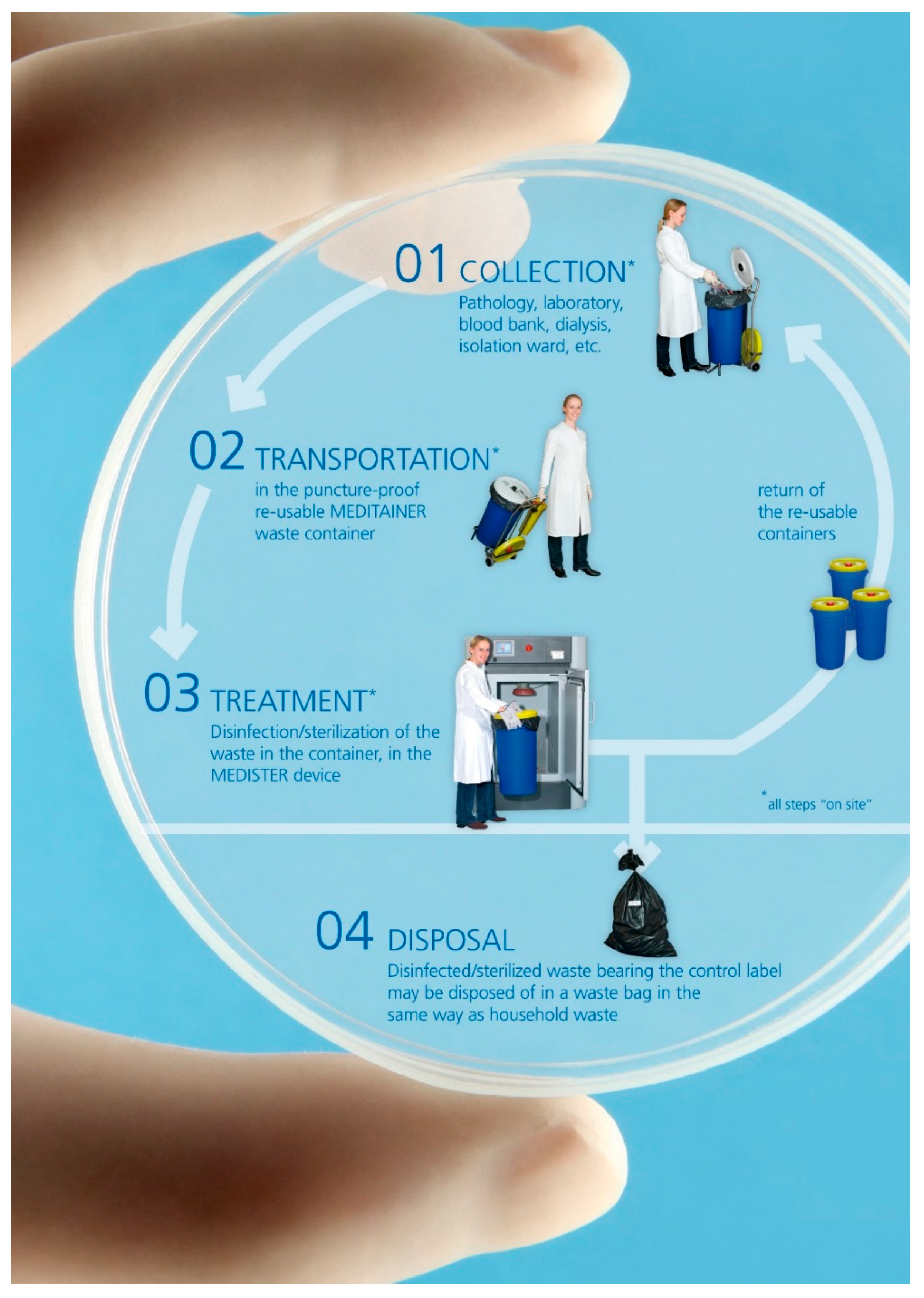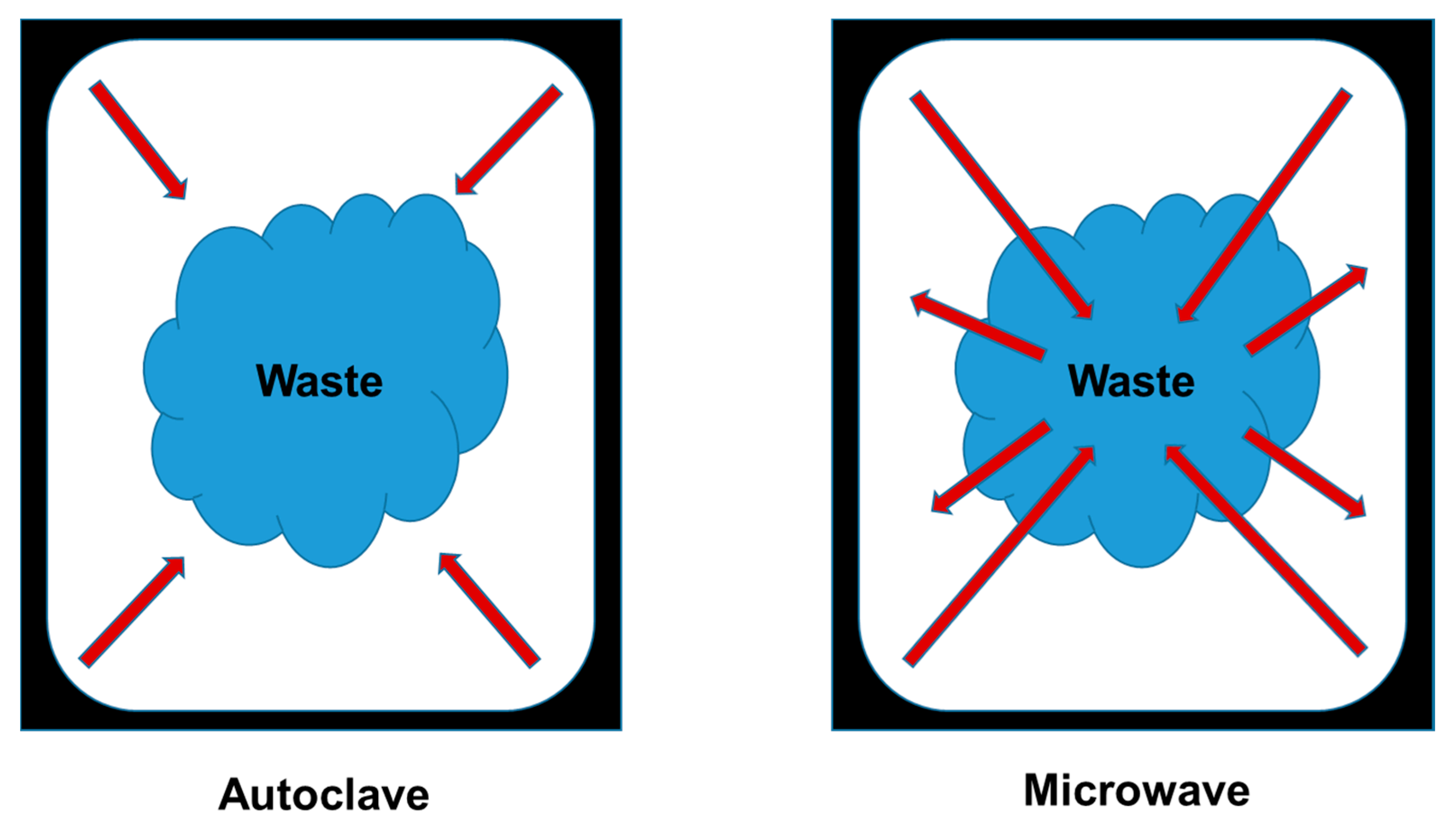Microwave Technologies: An Emerging Tool for Inactivation of Biohazardous Material in Developing Countries
Abstract
:1. Introduction
2. Treatment Technologies and Challenges
3. Microwave: A Variety of Applications
4. Efficiency of Microwaves for Treating Biohazardous Waste
5. Advanced Microwave Technologies
6. Comparison of Technologies for Treatment of Biohazardous Waste
7. Examples for Use of Microwaves in Developing Countries
7.1. Sewage Sludge
7.2. Healthcare Waste
8. Conclusions
Conflicts of Interest
References
- Afolabi, O.O.D.; Sohail, M. Microwaving human faecal sludge as a viable sanitation technology option for treatment and value recovery—A critical review. J. Environ. Manag. 2017, 1, 401–415. [Google Scholar] [CrossRef] [PubMed]
- UNEP. Compendium of Technologies for Treatment/Destruction of Healthcare Waste; United Nations Environment Programme (UNEP), UNEP DTIE International Environmental Technology Centre (IETC): Nairobi, Kenya, 2012. [Google Scholar]
- World Health Organization (WHO). Safe Management of Wastes from Health-Care Activities, 2nd ed.; Chartier, Y., Emmanuel, J., Pieper, U., Prüss, A., Rushbrook, P., Stringer, R., Townend, W., Susan Wilburn, S., Zghondi, R., Eds.; World Health Organization: Geneva, Switzerland, 2014. [Google Scholar]
- Wu, J.; Li, C.; Huo, Y. Safety assessment of dangerous goods transport enterprise based on the relative entropy aggregation in group decision making model. Comput. Intell. Neurosci. 2014, 571058. [Google Scholar] [CrossRef] [PubMed]
- Diaz, L.F.; Savage, G.M.; Eggerth, L.L. Alternatives for the treatment and disposal of healthcare wastes in developing countries. Waste Manag. 2005, 25, 626–637. [Google Scholar] [CrossRef] [PubMed]
- De Titto, E.; Savino, A.A.; Townend, W.K. Healthcare waste management: The current issues in developing countries. Waste Manag. Res. 2012, 30, 559–561. [Google Scholar] [CrossRef] [PubMed]
- RKI (Robert-Koch-Institut). Liste der vom RKI geprüften und anerkannten Desinfektionsmittel und-verfahren. Bundesgesundheitsblatt-Gesundheitsforschung-Gesundheitsschutz 2013, 56, 1706–1728. [Google Scholar] [CrossRef]
- Caniato, M.; Tudor, T.; Vaccari, M. International governance structures for health-care waste management: A systematic review of scientific literature. J. Environ. Manag. 2015, 153, 93–107. [Google Scholar] [CrossRef] [PubMed]
- Johnson, K.M.; González, M.L.; Dueñas, L.; Gamero, M.; Relyea, G.; Luque, L.E.; Caniza, M.A. Improving waste segregation while reducing costs in a tertiary-care hospital in a lower-middle-income country in Central America. Waste Manag. Res. 2013, 31, 733–738. [Google Scholar] [CrossRef] [PubMed]
- Sharma, S.; Chauhan, S.V. Assessment of bio-medical waste management in three apex government hospitals of Agra. J. Environ. Biol. 2008, 29, 159–162. [Google Scholar] [PubMed]
- Nandwani, S. Study of biomedical waste management practices in a private hospital and evaluation of the benefits after implementing remedial measures for the same. J. Commun. Dis. 2010, 42, 39–44. [Google Scholar] [PubMed]
- Zhang, H.J.; Zhang, Y.H.; Wang, Y.; Yang, Y.H.; Zhang, J.; Wang, Y.L.; Wang, J.L. Investigation of medical waste management in Gansu Province, China. Waste Manag. Res. 2013, 31, 655–659. [Google Scholar] [CrossRef] [PubMed]
- Tonuci, L.R.; Paschoalatto, C.F.; Pisani, R., Jr. Microwave inactivation of Escherichia coli in healthcare waste. Waste Manag. 2008, 28, 840–848. [Google Scholar] [CrossRef] [PubMed]
- Bélanger, J.M.; Paré, J.R.; Poon, O.; Fairbridge, C.; Ng, S.; Mutyala, S.; Hawkins, R. Remarks on various applications of microwave energy. J. Microw. Power Electromagn. Energy 2008, 42, 24–44. [Google Scholar] [CrossRef] [PubMed]
- Park, D.K.; Bitton, G.; Melker, R. Microbial inactivation by microwave radiation in the home environment. J. Environ. Health 2006, 69, 17. [Google Scholar] [PubMed]
- Gulati, A.; Rawat, R.; Singh, B.; Ravindranath, S.D. Application of microwave energy in the manufacture of enhanced-quality green tea. J. Agric. Food Chem. 2003, 51, 4764–4768. [Google Scholar] [CrossRef] [PubMed]
- Song, W.J.; Kang, D.H. Inactivation of Salmonella Senftenberg, Salmonella Typhimurium and Salmonella Tennessee in peanut butter by 915 MHz microwave heating. Food Microbiol. 2016, 53, 48–52. [Google Scholar] [CrossRef] [PubMed]
- Huang, L.; Sites, J. New automated microwave heating process for cooking and pasteurization of microwaveable foods containing raw meats. J. Food Sci. 2010, 75, E110–E115. [Google Scholar] [CrossRef] [PubMed]
- Sheen, S.; Huang, L.; Sommers, C. Survival of Listeria monocytogenes, Escherichia coli O157:H7, and Salmonella spp. on catfish fillets exposed to microwave heating in a continuous mode. J. Food Sci. 2012, 77, E209–E214. [Google Scholar] [CrossRef] [PubMed]
- Hecq, D.; Jamart, J.; Galanti, L. Microwave freeze-thaw treatment of dose-banded cytotoxics injectable drugs: A review of the literature from 1980 to 2011. Ann. Pharm. Fr. 2012, 70, 227–235. [Google Scholar] [CrossRef] [PubMed]
- Craciun, G.; Martin, D.; Togoe, I.; Tudor, L.; Manaila, E.; Ighigeanu, D.; Matei, C. Vaccine preparation by radiation processing. J. Microw. Power Electromagn. Energy 2009, 43, 65–70. [Google Scholar] [CrossRef] [PubMed]
- Kokolakis, A.K.; Golfinopoulos, S.K. Microwave-assisted techniques (MATs); a quick way to extract a fragrance: A review. Natl. Prod. Commun. 2013, 8, 1493–1504. [Google Scholar]
- Delazar, A.; Nahar, L.; Hamedeyazdan, S.; Sarker, S.D. Microwave-assisted extraction in natural products isolation. Methods Mol. Biol. 2012, 864, 89–115. [Google Scholar] [CrossRef] [PubMed]
- Chan, C.H.; Yusoff, R.; Ngoh, G.C.; Kung, F.W. Microwave-assisted extractions of active ingredients from plants. J. Chromatogr. A 2011, 1218, 6213–6225. [Google Scholar] [CrossRef] [PubMed]
- Al-Hakami, S.M.; Khalil, A.B.; Laoui, T.; Atieh, M.A. Fast Disinfection of Escherichia coli Bacteria Using Carbon Nanotubes Interaction with Microwave Radiation. Bioinorg. Chem. Appl. 2013, 458943. [Google Scholar] [CrossRef]
- Guideline Hospital Waste Decontamination Equipment; VROM, Ministry of Housing, Spatial Planning and the Environment: Hague, The Netherlands, 2006.
- Goldblith, S.A.; Wang, D.I. Effect of Microwaves on Escherichia coli and Bacillus subtilis. Appl. Microbiol. 1967, 15, 1371–1375. [Google Scholar] [PubMed]
- Souhrada, L. Sterilization wave of the future: Microwaves. Hospitals 1989, 63, 44. [Google Scholar] [PubMed]
- Hoffman, P.N.; Hanley, M.J. Assessment of microwave-based clinical waste decontamination unit. J. Appl. Bacteriol. 1994, 77, 607–612. [Google Scholar] [CrossRef] [PubMed]
- Edlich, R.F.; Borel, L.; Jensen, H.G.; Winters, K.L.; Long, W.B., III; Gubler, K.D.; Buschbacher, R.M.; Becker, D.G.; Chang, D.E.; Korngold, J.; et al. Revolutionary advances in medical waste management. The Sanitec system. J. Long-Term Eff. Med. Implants 2006, 16, 9–18. [Google Scholar] [CrossRef] [PubMed]
- Veronesi, P.; Leonelli, C.; Moscato, U.; Cappi, A.; Figurelli, O. Non-incineration microwave assisted sterilization of medical waste. J. Microw. Power Electromagn. Energy 2007, 40, 211–218. [Google Scholar] [CrossRef] [PubMed]
- Katschnig, H. Integriertes, kostengünstiges und umweltschonendes Sicherheitsabfallentsorgungskonzept für die Dialysestation. Diatra J. 1993, 4, 19–25. [Google Scholar]
- Mucha, H. Desinfektion von infektiösen Gütern mittels Hochfrequenzverfahren. Aseptica 2001, 1, 18–20. [Google Scholar]
- Zimmermann, K. Microwave as an emerging technology for the treatment of biohazardous waste: A mini-review. Waste Manag. Res. 2017, 35, 471–479. [Google Scholar] [CrossRef] [PubMed] [Green Version]
- Chen, Y.; Ding, Q.; Yang, X.; Peng, Z.; Xu, D.; Feng, Q. Application countermeasures of non-incineration technologies for medical waste treatment in China. Waste Manag. Res. 2013, 31, 1237–1244. [Google Scholar] [CrossRef] [PubMed]
- Alagöz, B.A.; Kocasoy, G. Treatment and disposal alternatives for health-care waste in developing countries—A case study in Istanbul, Turkey. Waste Manag. Res. 2007, 25, 83–89. [Google Scholar] [CrossRef] [PubMed]
- Özkan, A. Evaluation of healthcare waste treatment/disposal alternatives by using multi-criteria decision-making techniques. Waste Manag. Res. 2013, 31, 141–149. [Google Scholar] [CrossRef] [PubMed]
- Soares, S.R.; Finotti, A.R.; da Silva, V.P.; Alvarenga, R.A. Applications of life cycle assessment and cost analysis in health care waste management. Waste Manag. 2013, 33, 175–183. [Google Scholar] [CrossRef] [PubMed]
- Graczyk, T.K.; Kacprzak, M.; Neczaj, E.; Tamang, L.; Graczyk, H.; Lucy, F.E.; Girouard, A.S. Human-virulent microsporidian spores in solid waste landfill leachate and sewage sludge, and effects of sanitization treatments on their inactivation. Parasitol. Res. 2007, 101, 569–575. [Google Scholar] [CrossRef] [PubMed]
- Cella, M.A.; Akgul, D.; Eskicioglu, C. Assessment of microbial viability in municipal sludge following ultrasound and microwave pretreatments and resulting impacts on the efficiency of anaerobic sludge digestion. Appl. Microbiol. Biotechnol. 2016, 100, 2855–2868. [Google Scholar] [CrossRef] [PubMed]
- Zhou, B.W.; Shin, S.G.; Hwang, K.; Ahn, J.H.; Hwang, S. Effect of microwave irradiation on cellular disintegration of Gram positive and negative cells. Appl. Microbiol. Biotechnol. 2010, 87, 765–770. [Google Scholar] [CrossRef] [PubMed]
- Pino-Jelcic, S.A.; Hong, S.M.; Park, J.K. Enhanced anaerobic biodegradability and inactivation of fecal coliforms and Salmonella spp. in wastewater sludge by using microwaves. Water Environ. Res. 2006, 78, 209–216. [Google Scholar] [CrossRef] [PubMed]
- Hong, S.M.; Park, J.K.; Teeradej, N.; Lee, Y.O.; Cho, Y.K.; Park, C.H. Pretreatment of sludge with microwaves for pathogen destruction and improved anaerobic digestion performance. Water Environ. Res. 2006, 78, 76–83. [Google Scholar] [CrossRef] [PubMed]
- Mawioo, P.M.; Hooijmans, C.M.; Garcia, H.A.; Brdjanovic, D. Microwave treatment of faecal sludge from intensively used toilets in the slums of Nairobi, Kenya. J. Environ. Manag. 2016, 184, 575–584. [Google Scholar] [CrossRef] [PubMed]
- Nguyen, T.A.; Babel, S.; Boonyarattanakalin, S.; Koottatep, T. Rapid and Decentralized Human Waste Treatment by Microwave Radiation. Water Environ. Res. 2017, 89, 652–662. [Google Scholar] [CrossRef] [PubMed]
- Zhou, C.; Huang, X.; Zeng, M. Experimental continuous sludge microwave system to enhance dehydration ability and hydrogen production from anaerobic digestion of sludge. J. Environ. Sci. (China) 2018, 67, 145–153. [Google Scholar] [CrossRef] [PubMed]
- Liu, J.; Yang, M.; Zhang, J.; Zheng, J.; Xu, H.; Wang, Y.; Wei, Y. A comprehensive insight into the effects of microwave-H2O2 pretreatment on concentrated sewage sludge anaerobic digestion based on semi-continuous operation. Bioresour. Technol. 2018, 256, 118–127. [Google Scholar] [CrossRef] [PubMed]
- Kavitha, S.; Banu, J.R.; Kumar, G.; Kaliappan, S.; Yeom, I.T. Profitable ultrasonic assisted microwave disintegration of sludge biomass: Modelling of biomethanation and energy parameter analysis. Bioresour. Technol. 2018, 254, 203–213. [Google Scholar] [CrossRef] [PubMed]
- Tong, J.; Liu, J.; Zheng, X.; Zhang, J.; Ni, X.; Chen, M.; Wei, Y. Fate of antibiotic resistance bacteria and genes during enhanced anaerobic digestion of sewage sludge by microwave pretreatment. Bioresour. Technol. 2016, 217, 37–43. [Google Scholar] [CrossRef] [PubMed] [Green Version]
- Liu, H.C.; Wu, J.; Li, P. Assessment of health-care waste disposal methods using a VIKOR-based fuzzy multi-criteria decision making method. Waste Manag. 2013, 33, 2744–2751. [Google Scholar] [CrossRef] [PubMed]
- Ojha, S.C.; Chankhamhaengdecha, S.; Singhakaew, S.; Ounjai, P.; Janvilisri, T. Inactivation of Clostridium difficile spores by microwave irradiation. Anaerobe 2015, 38, 14–20. [Google Scholar] [CrossRef] [PubMed]
- Oliveira, E.A.; Nogueira, N.G.; Innocentini, M.D.; Pisani, R., Jr. Microwave inactivation of Bacillus atrophaeus spores in healthcare waste. Waste Manag. 2010, 30, 2327–2335. [Google Scholar] [CrossRef] [PubMed]
- Wei, G.X.; Liu, H.Q.; Zhang, R.; Zhu, Y.W.; Xu, X.; Zang, D.D. Application of microwave energy in the destruction of dioxins in the froth product after flotation of hospital solid waste incinerator fly ash. J. Hazard. Mater. 2017, 325, 230–238. [Google Scholar] [CrossRef] [PubMed]


| Conventional (“Household”) Microwave | Sophisticated Microwave (Controlled Heat and Moisture) | |
|---|---|---|
| Cost for device | Low | High |
| Energy consumption | Low | Low |
| Water consumption | None | Low |
| Control of inactivation process | Difficult | Very good |
© 2018 by the author. Licensee MDPI, Basel, Switzerland. This article is an open access article distributed under the terms and conditions of the Creative Commons Attribution (CC BY) license (http://creativecommons.org/licenses/by/4.0/).
Share and Cite
Zimmermann, K. Microwave Technologies: An Emerging Tool for Inactivation of Biohazardous Material in Developing Countries. Recycling 2018, 3, 34. https://doi.org/10.3390/recycling3030034
Zimmermann K. Microwave Technologies: An Emerging Tool for Inactivation of Biohazardous Material in Developing Countries. Recycling. 2018; 3(3):34. https://doi.org/10.3390/recycling3030034
Chicago/Turabian StyleZimmermann, Klaus. 2018. "Microwave Technologies: An Emerging Tool for Inactivation of Biohazardous Material in Developing Countries" Recycling 3, no. 3: 34. https://doi.org/10.3390/recycling3030034
APA StyleZimmermann, K. (2018). Microwave Technologies: An Emerging Tool for Inactivation of Biohazardous Material in Developing Countries. Recycling, 3(3), 34. https://doi.org/10.3390/recycling3030034




